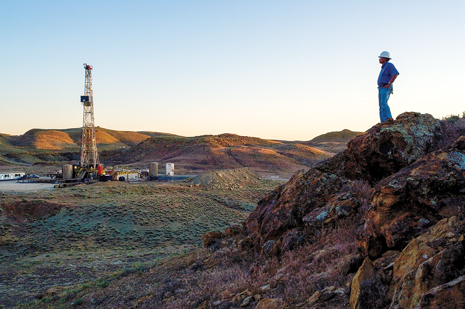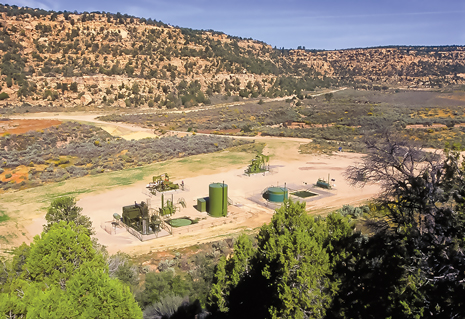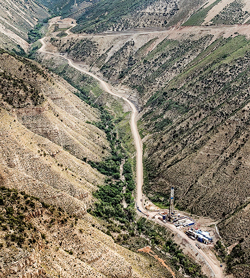 |
| Faced with a 20% drop in Brent and WTI oil prices, and a natural gas price at the Henry Hub below $4/Mcf, operators in the western U.S. will have to depend on operating efficiency and technology innovation to achieve a lucrative return on their shale and tight oil activity. The photo shows an Anadarko rig operating in the Uinta basin (photo courtesy of Anadarko Petroleum). |
|
It has been only 11 years since the Barnett shale took off with the drilling and fracing of its first horizontal well. Since then, we’ve seen the discovery of several prolific shale gas or tight oil plays in the U.S.—Marcellus, Haynesville, Bakken, Eagle Ford, Woodford, Permian and Niobrara. Could there be other such shale superstars waiting in the wings? If there are, the most likely candidates are in the vast expanse of the American West. A few majors, and a large number of independents, are applying their intuition and lessons learned to crack the code in the Piceance, Powder River, Uinta, and even the now-diminished Monterey basin, and the emerging oil play in the San Juan basin.
GETTING SMALL AND NIMBLE
BP North America and ExxonMobil’s XTO Energy division are major producers of North American conventional natural gas. XTO is active in the Piceance basin, and both XTO and BP are operating in the San Juan basin. There is, however, little public disclosure about their unconventional gas or oil activities. Undoubtedly, the opportunities in the shale and tight oil sector cannot be lost on these major players. In fact, BP is creating a separate business for its U.S. Lower 48 activities. “There is potential for improvement when compared to the U.S. independent peer group,” explained Lamar McKay, BP Chief Executive, U.S. Upstream, during a recent investor presentation. “Speed of innovation, faster decision-making and shorter cycle times necessitate a new business model.”
POWDER RIVER BASIN
Stretching 24,000 sq mi across northeastern Wyoming and southeastern Montana, the Power River basin is recognized primarily for its coal deposits. The tight sandstone play is associated with the Upper Cretaceous Niobrara and Frontier formations, and the Parkman, Turner, Shannon and Sussex members. The sedimentary column is as thick as 18,000 ft in the western portion.
Anadarko Petroleum. The firm continues to successfully test multiple oil objectives across its approximately 350,000-net-acre position in the Powder River basin. The company produces from 32 operated wells and has filed permits to begin pad drilling. Anadarko operated one rig and drilled three wells during second-quarter 2014. In Salt Creek field, Anadarko is conducting a CO2 flood to increase production from a century-old field.
Linn Energy. In April 2012, Linn entered into a JV agreement to develop Salt Creek Field in the Powder River basin. The company’s properties consist of Anadarko’s CO2 flood in Salt Creek field. Properties, acquired recently from Berry Petroleum, produce from the Green River and Wasatch formations in the Uinta basin at depths ranging from 5,000 to 7,500 ft, and from the Williams Fork formation in the Piceance basin at depths ranging from 7,500 to 9,500 ft.
Devon Energy. Having assembled 150,000 net acres, Devon is targeting stacked oil targets in the Parkman, Turner and Frontier formations. Using three rigs, the company drilled two high-rate wells in second-quarter 2014 with a 30-day IP date of 950 boed (95% light oil). By year-end, Devon expects to add a fourth rig and plans to accelerate development activity in 2015.
EOG Resources. EOG has gathered 93,000 net acres, divided between 30,000 acres targeting the Parkman member and 63,000 acres for the Turner member. Having been active in the Powder River basin for eight years, EOG drilled 34 wells in 2014. The lateral lengths have been as long as 7,300 ft for Parkman wells, at 1,300-ft spacing, and 8,200 ft for Turner wells at 1,655 ft. Parkman wells have a greater oil portion (69% oil, 11% NGL and 20% gas) than Turner wells (34% oil, 23% NGLs and 43% gas).
Vanguard Natural Resources. As part of a strategy to grow through the acquisition of mature producing fields with significant upside potential, Houston-based Vanguard has established a stake in the Piceance basin with properties producing 103.6 MMcfed (4% oil, 69% natural gas and 26% NGLs). The proved reserves are 502 Bcfe. Vanguard is focusing on the Gibson Gulch area, a basin-centered gas play along the north end of the Divide Creek anticline, near the eastern limits of the Piceance basin’s productive Mesa Verde trend at a depth of 7,500 ft. In 2014, the company has planned to increase production through artificial lift installations.
PICEANCE BASIN
The Piceance is a tight sandstone basin stretching over 6,000 sq mi across northeastern Colorado. The U.S. Geological Survey (USGS) estimates that the potential gas reserves in the basin are in excess of 300 Tcf. The primary target is the Green River formation of the Cretaceous age.
WPX Energy is producing 1.3 MMcfgd at 7,325 psi (80% natural gas, 20% NGLs) from the Ryan Gulch. The company boasts a 25-year inventory of drilling prospects.
Vanguard Natural Resources. The Houston-based independent produces 103.6 MMcfed of net production from proved reserves of 502 Bcfe. The production consists of 75% natural gas and 25% NGLs. Vanguard acquired these properties in July 2014 from Bill Barrett Corp. for an adjusted purchase price of $508.7 million.
UINTA BASIN
Several independent operators are producing black or yellow waxy crude from the Wasatch and Green River formations in three areas within the Uinta basin. The operators are working with five refineries in the Salt Lake City region that are accepting 65,000 bopd, with plans to expand the feedstock intake during 2015 by an additional 40,000 bopd.
Newfield Exploration. With 225,000 net acres in the Uinta basin, Newfield divides its operations into the Greater Monument Butte Unit (GMBU) waterflood and Central basin, an area to the north. Since 2004, Newfield has drilled more than 1,700 wells, with more than 1,300 productive oil wells. In the GMBU, the primary producing horizon is the Green River formation. Newfield is exploring deeper vertical and horizontal plays in the Central Basin acreage, including the Uteland Butte and Wasatch formations.
Newfield has allocated approximately $400 million to the Uinta basin program in 2014, divided between the GMBU and the Central basin. Newfield’s net production in the basin has grown from 7,000 boed in 2004 to 24,250 boed, consisting of 19,200 bopd, 950 boed of NGLs and 25 MMcfgd at year-end 2013.
Anadarko Petroleum. In the Greater Natural Buttes, Anadarko holds net 189,000 acres. In second-quarter 2014, net sales volumes averaged approximately 560 MMcfgd for the quarter, up 6% from second-quarter 2013. Anadarko operated three rigs and drilled 48 wells during this period.
Bill Barrett Corporation (BBC) has acquired 152,130 net acres in the Uinta basin, divided up as follows: 23,675 net acres in East Bluebell; 108,255 net acres in Blacktail Ridge/Lake Canyon; and 20,200 net acres in South Altamont. BBC produced 6,375 boed from a resource base of 53 MMboe in proved reserves, Fig. 1. In East Bluebell field, BBC drilled 20 vertical wells into the Lower Green River formation during 2013 on an 80-acre development plan. In 2014, the company plans to drill 29 net wells. Since 2012, BBC has been able to reduce drilling days per well from 18.1 to 10, and drilling costs from $184/ft to $93/ft.
 |
| Fig. 1. Bill Barrett has produced 6,375 boed in the Uinta basin from a resource base of 53 MMboe (photo courtesy of Bill Barrett Corporation). |
|
Ultra Petroleum. The Houston-based independent has 91 MMboe of potential reserves. The company has budgeted $800 million to drill 550 wells at an F&D cost of $8.79/boe.
MONTEREY SHALE
The Monterey basin extends throughout the state of California, but the shale of interest covers about 1,750 sq mi in central and southern California. Even though the Miocene-age shale is 1,000 to 3,000 ft thick, at a depth of 8,000 to 14,000 ft, the formation was disturbed through tectonic activity to create a complex fold of mudstone and chert that is very difficult to drill. According to Wood Mackenzie, the Monterey shale will produce about 76,000 boed, consisting of 85 MMcfgd and 61,000 bpd of crude, condensate and NGLs.
Acid fracing. Many of the shale formations are composed of calcium carbonates that can be dissolved through acid to release the hydrocarbons. In 2000, Occidental Petroleum tested acidizing with large-volume hydrofluoric acid to increase the average well production by 110 bopd, at a lifting cost of about $10/bbl. As a result, most of the wells in the Monterey shale are vertically drilled and acid-fraced.
Lower potential estimate. In late August 2014, the USGS lowered its estimate 96%, to merely 600 MMbbl as a result of the difficulty in extracting the resources. Besides the complex geology, the USGS estimate was tempered by the regulatory restrictions and public opposition to drilling and fracing. As a result of this massive drop-off, the Monterey has diminished from what was to be the leading U.S. shale play, with two-thirds of the country’s shale reserves, to a minor prospect. According to the USGS, the earlier estimate had assumed broadly that deposits in the Monterey shale formation were as easily recoverable as those in Bakken or Eagle Ford.
California Resources Corporation. At the end of 2014, Occidental Petroleum plans to transfer all of its California assets into a new corporation called California Resources Corporation. As a pure-play California enterprise, the company will be able to spend virtually all of its cash flow to grow production, reserves and earnings. without having to compete with Occidental’s projects elsewhere in the U.S. and the world. The company has over 1.2 million acres in the Monterey shale, mostly in Kern County.
Venoco Inc. The small independent has producing properties, both offshore and onshore California. A substantial portion of the company’s production is from offshore wells targeting the fractured Monterey shale formation. Onshore, Venoco had shale acreage totaling 57,000 net acres, which is primarily in three basins: Santa Maria, Salinas Valley and San Joaquin. Since 2010, Venoco had pursued an active drilling program targeting the onshore Monterey shale formation. This included the drilling of 29 wells and setting casing in 26 of them. However, disappointing results have forced Venoco to reduce capital expenditures in the Monterey shale. At this time, Venoco is pinning its hopes on Sevier field in the San Joaquin basin, which may become commercial.
SAN JUAN BASIN
Situated in the Four Corners region, the San Juan basin extends 4,600 sq mi across northwestern New Mexico, southwestern Colorado, and parts of Arizona and Utah. The basin has a history of natural gas production, but most operators are targeting the Gallup sandstone and Mancos shale members to develop a tight shale oil play.
Encana Energy. The Canadian company claims to be the first mover in this emerging play, having acquired 176,000 net acres in the oil sector. According to Encana, the play is capable of 50,000 boed with 30-day IPs of 400 bopd to 500 bopd.
WPX Energy. While WPX has more than 30 years of experience in San Juan Gallup, the company only recently increased its holdings to 84,000 net acres, representing a 163% increase from year-end 2013. In 2014, WPX added a third rig and achieved a record 9.5 days per well while completing 7,500-ft laterals. The production stream consists of 70% oil, 15% natural gas and 15% NGLs. The basin capacity is expected to be 100 MMbopd in 2015 and 125 MMbopd in 2016.
Energen established a presence in the San Juan basin in 1997, with the acquisition of 319 Bcfe of proved reserves from Burlington Resources. The company has 75,000 net acres in the oil window. It has drilled four gross wells as a non-operating partner with WPX, but it is planning to field a rig of its own in 2015.
ConocoPhillips’ San Juan business unit has acquired 900,000 net acres of leases and operates more than 1,000 natural gas wellsites that are on, or near, four Native American reservations. Low natural gas prices have diminished COP’s activities in the region, but several wells have targeted the Mancos shale in favor of oil production, Fig. 2.
 |
| Fig. 2. ConocoPhillips has been active in the San Juan basin near several Native American reservations (photo courtesy of ConocoPhillips). |
|
TECHNOLOGY APPLICATIONS
Using seismic to target sweet spots. Devon Energy has enhanced production from the Uinta basin’s Bluebell field through the use of 3D seismic mapping,. The latter has been used to identify areas of high fracture density in the productive Eocene Green River formation-to-Paleocene Wasatch formation interval and to match that against cumulative fluid production to find under-drained areas for future well locations. A 35-sq-mi-wide azimuth, 3D seismic program was conducted in 2010–2011 over a portion of the field. Post-stack multi-attribute statistical analysis was conducted over three reservoir intervals in the Wasatch interval, since the Wasatch had produced over 80% of the cumulative production. The analysis consisted of seismic attribute selection and optimization by step-wise multi-variate linear regression, using cross-validation techniques, which included hidden well prediction. The resultant map of predicted fracture network was then correlated with cumulative fluid production from the first Wasatch well in each section. Best results were obtained over one of the three modeled reservoir intervals. This reservoir interval, approximately 700 ft thick, correlated with the most prolific oil-producing zone from previous geologic work. The practical application of this technique, along with offsetting well drainage patterns, enabled Devon Energy to high-grade future drilling locations.
Split rig for narrow canyons. WPX worked with Nabors Drilling to modify an existing rig to fit into the tight, narrow canyons and topography of the Rocky Mountains, Fig. 3. The result is a “split rig” that separates the derrick from other parts of the rig’s tanks, engines and equipment, by up to 400 ft. The setup requires about half the acreage of a typical drilling pad. Additional operating efficiencies were introduced through simultaneous operations (SIMOPS) to drill, complete and produce wells on the same pad, at the same time, and clustered plans of development (CPODS), to use a centralized, remote location to fracture and stimulate as many as 22 wells from a single site. In addition, remote hydraulic fracturing pads are set up about 100 yards from the wells, to save time and production cost.
 |
| Fig. 3. WPX Energy worked with Nabors Drilling to develop a split rig package, to ease transport of rig equipment through narrow canyons in the Rocky Mountain region (photo courtesy of WPX Energy). |
|
SHALE MINOR LEAGUE?
A large variety of majors, independents and private-equity-funded minnows are working throughout the Western U.S. in shale gas and tight oil plays. Individually, none of these may reach the major league status of the Bakken or the Eagle Ford. But collectively, these plays represent a significant portion of U.S. current production and future prospects. As has been proven in the Gulf of Mexico, it is possible for majors to achieve commercial success operating in deep waters and for small independents to achieve on the shelf. As such, we may be seeing an emergence of an equally successful minor league of U.S. shale plays. 
|







